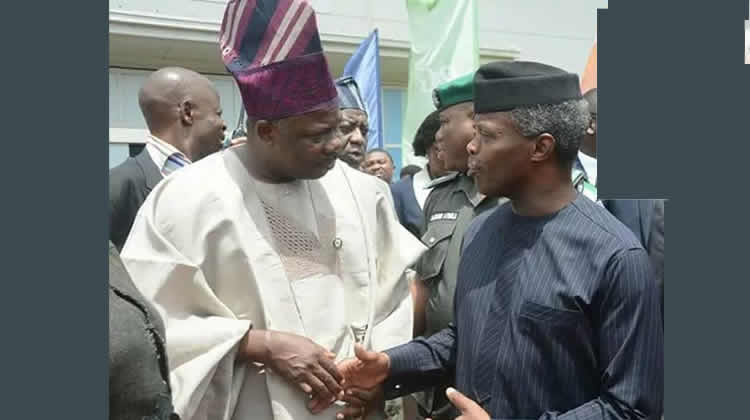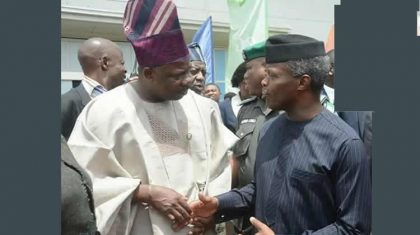Headlines
Amosun, Osinbajo battle for the control of Ogun

By AYOOLA OLAOLUWA
Even before its creation in 1976 by the then regime of General Murtala Mohammed, Ogun State has been a battleground between the Ijebu, Remo, Egba and Egbado (now Yewa).
Known as the ‘Gateway State’, the state has never really been one homogenous entity. It existed as a number of independent and competitive nations until it was carved out from the old Western Region.
The Egba and Remo fought a bitter four-year war known as the Egba-Remo War of 1862-1865. During the war of succession between Ibadan and Ijaiye in 1881-1882 over who to succeed the old Oyo Empire as the political head of Yorubaland after its defeat by the Fulanis in 1836, the Egba had supported Ijaye, while the Ijebu Remo supported Ibadan.
The Egbas, displeased with the actions of the Ijebu-Remo and Ikorodu, one of the Remo towns, sought to punish them, but the British army prevented this by defeating the Egba army. The Egbas avenged this in 1867 by expelling all British missionaries in Egbaland and burned the printing house of Iwe Irohin, the first newspaper in Nigeria by Rev. Henry Townsend.
Britain was requested to intervene in the region by Yoruba kings to stop the ravages of the battles. Towards achieving peace between the two feuding brothers, the British conquered Egbaland, Ijebuland and Remi Kingdoms as part of the Southern Protectorates, along with the Colony of Lagos.
However, the rivalry, which has shifted to a battle for political and economic dominance, has continued between the four divisions of Ijebu, Remo, Egba and Egbado, then (now Yewa), after the creation of Ogun. There are also sub-groups like the Ikale, Ketu, Ohori and Anago.In the quest for power and relevance, Ogun East, made up of the Ijebu-Remos, and Ogun Central, consisting of the Egbas have both gained prominence, while Ogun West, consisting of the Yewas and Aworis, had been treated like second class citizens. The zone, apart from been economically disadvantaged, remains the only senatorial zone that is yet to produce a governor in the state 42 years ago
The 2019 elections, perhaps more than previous contests, promise to be the most ferocious battle among the warring factions. Unlike in 2011 when the state Governor, Senator Ibikunle Amosun, rode to power on a popular mandate and consolidated his hold on the politics of the state with re-election in 2015, his move to install his successor during the March 2, 2019 polls is going to be a herculean task, Business Hallmark findings revealed.
In his plot to install his successor, Amosun is squaring against forces that helped him to power.
Against all odds
According to BH findings, the current political situation in the state is a fallout of the power struggle between Governor Amosun on one hand and former governors of Lagos and Ogun State, Asiwaju Bola Ahmed Tinubu and Chief Segun Osoba and Vice President Yemi Osinbajo ahead of the 2019 polls.
In 2011, both Tinubu and Osoba, against all odds, had ensured the emergence and electoral victory of Amosun on the platform of the defunct Action Congress of Nigeria (ACN). Amosun, adopted as a consensus candidate to end the reign of PDP in the state, was wooed from the now defunct All Nigeria Peoples Party (ANPP) to fly the APC ticket. But Amosun later fell out with the two key political figures, especially in the run-up to the 2015 elections.
During the intense battle to retain his seat in 2015, Tinubu and Osoba were believed to have worked against Amosun. But the incumbent Ogun governor managed to weather the storm, forcing Osoba and his supporters to defect to the relatively unknown Social Democratic Party (SDP), on whose platform they contested and lost the elections, while he also defeated the opposition Peoples Democratic Party candidate, General Idowu Olurin (retd), to eventually secure a second term in office.
Unfortunately for Amosun, his resolve to produce his successor, in the person of Hon. Adekunle Akinlade, a serving member of the House of Representatives who represents Egbado South and Ipokia Federal Constituency in the House of Representatives, has further pitched him against powerful forces and interest groups from in and outside the state.
Tinubu’s master stroke
It was reliably gathered that Asiwaju Bola Ahmed Tinubu played a deft hand in the emergence of Dapo Abiodun as the candidate of the APC in the state. Tinubu, it was gathered, had initially backed a serving National Assembly member, Senator Solomon Adeola, popularly known as Yayi, as the next governor of the state.
However, the choice of Yayi pitched Amosun against Tinubu and Osoba who rooted for the candidacy of Adeola, who is from Yewa. The Tinubu group was forced to make a retreat following Yewa people’s vehement and hostile opposition to their bid. Buoyed by Amosun’s propaganda machine, Yayi was labeled a foreigner and a surrogate of Tinubu, an allegation that put paid to his governorship ambition.
While the resistance was on, a foxy Tinubu, it was learnt, had secretly dumped Yayi, backed Dapo Abiodun and called his camp in Ogun to work for his emergence as the flagbearer. APC Chairman, Adams Oshomole, who also belongs to Tinubu camp of ACN in APC caucus, also played a massive role in the routing of Amosun.
A close associate of the APC national leader, Alhaji Busari Inaolaji, told our correspondent that the choice of oil baron, Dapo Abiodun, had been in the pipeline right from beginning.
“Learning from their humbling experiences in Ondo and Kogi where their candidates were demonized as Tinubu proxies, the Tinubu group decided to change tactics. The realized there will be opposition to Yayi in Ogun State, so another candidate in the person of Abiodun was put on standby.
“Yayi was Tinubu’s object of distraction in the race for the Ogun flagbearer. While Amosun was working hard to fight against the emergence of Yayi, Tinubu’s camp quickly close their ranks and team up with the NWC led by Oshiomhole to insist on direct primaries.
“To better realize their plot of checkmating any resistance from the Yewa block and Amosun camp, the powerful Ijebu-Remo Kingdom was brought into the deal. Tinubu and his Egba supporters, decided to cede the governorship position to the Ijebu-Remo division, but with a caveat to pick the candidate from their camp.
“Vice President Yemi Osinbajo was saddled with the task of interfacing with his people. Respected within his Ijebu tribe, the vice president played a major role in the emergence of the APC governorship candidate”, said Alhaji Inaolaji.
According to Inaolaji, Oshiomhole was pivotal in ensuring the Ogun State chapter of APC endorses direct primaries against Gov Amosun’s call for consensus candidates and option of indirect primaries.
Ijebu/Remo Challenge
One of the formidable groups against Amosun’s quest to foster his candidate on the state is the Ijebu-Remo people. The Ijebus in the state are known to be the first Yoruba-speaking people to have contact with the Europeans in the early 14th century. They are also believed to be the first Yorubas to invent money made from cowry shells called ‘Owo Eyo’, which was accepted throughout Yorubaland before it was replaced by coins made from silver materials, when the Europeans came.
Our correspondent reliably gathered that governorship of the state has over the years been rotated between the two geopolitical divisions of Ijebu/Remo and Egba/Egbado.
Angered by Amosun’s decision to install a Yewa indigene as his successor, some prominent sons and daughters (both professionals and politicians) of Ijebu and Remo extraction in the APC formed the Ijebu Agenda to fight against the attempt to exclude Ogun East Senatorial District from the 2019 governorship contest.
While speaking with BH in Ijbu-Ode, members of the group argued that governorship of the state had traditionally been rotated on the basis of old-time colonial divisions of Egba and Ijebu blocs. They reckoned that since an Egba man is about to dismount the saddle, the successor should naturally emerge from Ijebu division. They also maintained that Egba and Egbado people (Yewa-Awori) belong to one division while the Ijebu and Remo people belong to the other division.
Members of the Ijebu Agenda include Aare Olu Teslim Dawodu; Chief Bisi Rodipe; Chief Olusoga Adenusi; Tokunbo Oshin; Dr. Gbolade Oshinowo; Basorun Adebisi Adesanya; Chief Olu Okuboyejo and Senator Dipo Odujinrin, among many others.
The promoters of the 2019 Ijebu Governorship Agenda saw the needs for the birth of the pressure group to persuade the state governor to shift his ground. So, the Tinubu group was well received when they were approached to form an alliance to defeat Amosun’s candidate.
Prominent indigenes from the Ijebu-Remo zone who spoke with BH in Ijebu-Ode, the political headquarters of Ijebu-Remoland, said the Egba/Egbado (Yewa) division is already currently running the last year of its two terms and that the governorship must shift to the Ijebu/Remo division of the state for eight years beginning from 2019 after which it would be the turn of the Egba/Egbado (Yewa) division which will be completing eight years by 2019.
“We waited for eight years. But in those eight years, the Ogun West people were not able to manage the number of contestants from their area. They are at it again now. Can you hold us liable for that?
“We will go into 2019 election and we shall defeat them. After eight years in Ijebu/Remo division, we shall support Yewa again,” said the Secretary of Ijebu-Remo Forum (IRF), Aare Olu Dawodu.
Also, an APC governorship aspirant from Ijebu-Remo Kingdom, Otunba Jimi Lawal, said “We have two provinces in Ogun State, Ijebu province and Egba province. Egba has a sub division; Egbado or Yewa. Ijebu has a sub division; Remo. An Ijebu man had been a governor, so when the chance came back to Ijebu province again, they said let us go to Remo.
“Egba man had been a governor in the person of Chief Olusegun Osoba and when it went back to Egba province, which was supposed to be given to Yewa, Amosun got it. So, Governor Amosun could not have used the Egba/Egbado tenure and come back to say Egba/Egbado again, it is not possible”, Lawal argued.
A check by Business Hallmark shows that so far, two sons of Ogun East have ruled the state. These are late Chief Olabisi Onabanjo (1979 – 1983) and Otunba Gbenga Daniel (2003 – 2011). While Onabanjo hailed from Ijebu division, Daniel came from Remo division of the senatorial district.
Similarly, two sons of Ogun Central have also governed the state. They include Osoba (1992 – 1993; 1999 – 2003) and Amosun (2011 till date).
The Egba/Obasanjo rebellion
Among the ‘godfathers’ he has also allegedly squared up to is a former President, Chief Olusegun Obasanjo, who appears to be backing a larch chunk of his Egba block against Amosun’s move to install his successor.
BH reliably gathered from reliably sources that the Egbas are angry with the attempt to distort the power sharing arrangement between the Ijebu-Remo and Egba-Egbado divisions.
“Even Obasanjo, as a sitting president, could not install a Yewa candidate, not to talk of Amosun, who is a nobody in Egbaland”, said a visibly angry Abeokuta native”, Chief Tajudeen Bajela.
He argued that Egba’s are too proud and independent to dictated to by one man.
“We (Egbas) have produced many outstanding and distinguished Nigerians, both dead and living. We have had prominent professionals like Chief F.R.A. Williams; Prince Bola Ajibola; Professor Thomas Lambo; Olukoye Ransome – Kuti, Akintola Williams, Bola Kuforiji-Olubi, Idris Sulaiman, Justice Adetokunbo Ademola – first indigenous Chief Justice of Nigeria, George Sodehinde Sowemimo, S. O. Lambo, Simeon Adebo, Wole Soyinka – of Egba mother, Fela Ransome-Kuti, Ebenezer Obey, Iyalode Tinubu, Mrs. Funmilayo Ransome-Kuti and Iyalode Bisi Tejuoso.
“In the political sector, we have given the country a military Head of State in the person of General Olusegun Obasanjo. We even produced one civilian president in the person of Chief M.K.O. Abiola who was elected on June 12, 1993 in the fairest and freest elections in Nigeria but he was not allowed to take his post following annulment of the landmark elections.
“There was also Ernest Adegunle Sonekan, the Interim Head of state. We also gave Nigeria Chief Olusegun Obasanjo in is coming as elected president of Nigeria between 1999 and 2007.
“We also produced Dimeji Saburi Bankole as Speaker of the House of Representatives. Egbaland was the cradle of Western Education in Nigeria and the birthplace of Christianity in the Country.
“So, he (Amosun) should know that he was asking for too much from us (Egba). We follow people we love and respect, not an emperor”, Chief Bajela said.
Uneven development
One of the arguments against Amosun by those opposed to his government is the concentration of development in Egbaland. This, they argued, necessitated the rejection of continuity of his policies and programmes in the person of Hon. Akinlade.
“Our insistence not to allow Amosun nominates a candidate for the party is a rejection of continuation in office. His infrastructural development is skewed to favour only Abeokuta North and Abeokuta South local councils out of 20 local councils in the state.
“The state government has constructed about 30 bridges with over twenty of those bridges concentrated in Abeokuta metropolis. Even the ones at Ilaro, Arepo, Ijebu Igbo, Magboro and others outside Abeokuta are still under contraction”, lamented a Sagumu indigene who resides in Lagos.
BH findings revealed that politicians from Ogun East senatorial districts are latching on this supposedly uneven development in the state, which saw many roads and infrastructure in Ijebuland in a state of disrepair, using it to stand against the governor in deciding the next candidate of the party.
Demography
Another factor that will determine the 2019 governorship race in Ogun State is demography. The present population figures and border delineation seems to favour Ogun East (Ijebu-Remo). Out of the 20 local government areas in the state, 9 are in Ijebu Remo. They are Ijebu North, 99,574; Sagamu, 82, 252; Ikenne, 44,905; Odoogbolu, 71,595; Ijebu North-East, 35652 voters; Ijebu Ode, 55294; Remo North, 39396; Ijebu North-East and Sagamu 82,252 voter.



